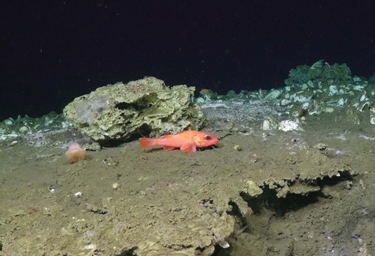Seeping seafloor may hold clues to earthquake hazards

The seafloor in the Cascadia Subduction Zone off Oregon is active with chemically distinct fluid seeping up from a spring beneath. Photo courtesy of the UW School of Oceanography.
The Cascadia Subduction Zone—the eerily quiet offshore fault that threatens to unleash a magnitude-9 earthquake in the Pacific Northwest—holds many mysteries. A recent UW-led study exploring the seafloor about 50 miles off Newport, Oregon, discovered seeps of warm, chemically distinct liquid shooting up.
The paper, published Jan. 25 in Science Advances, describes the unique underwater spring the researchers named Pythia’s Oasis. They think the spring is sourced from water 2.5 miles beneath the seafloor at the plate boundary, helping regulate stress on the offshore fault.
The team made the discovery during a weather-related delay for a research cruise aboard the RV Thomas G. Thompson. Sonar showed unexpected plumes of bubbles about three-quarters of a mile beneath the ocean’s surface. As the team explored the area with an underwater robot, they found the bubbles were just a minor component of warm, chemically distinct fluid gushing from the seafloor. The feature was discovered by Brendan Philip, then an undergraduate student and now a White House policy adviser.
Observations from later cruises show the fluid leaving the seafloor considerably warmer than the surrounding seawater. Calculations suggest the fluid is coming straight from the Cascadia megathrust, where temperatures are an estimated 150 to 250 degrees Celsius (300 to 500 degrees Fahrenheit).
The new seeps are unrelated to geologic activity at the nearby seafloor observatory the cruise was heading toward, says Evan Solomon, associate professor of oceanography. Instead, they occur near vertical faults that crosshatch the subduction zone. These strike-slip faults, where sections of ocean crust and sediment slide past each other, exist because the ocean plate hits the continental plate at an angle, placing stress on the overlying continental plate. This is the first known site of its kind. Researchers believe similar fluid seep sites may exist nearby, but they are hard to detect from the ocean’s surface.